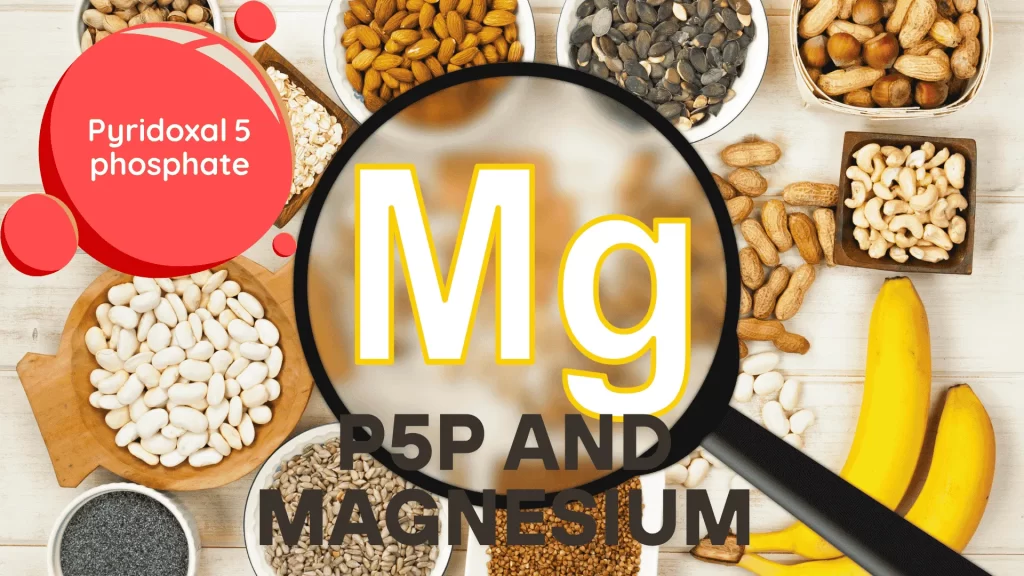P5P and Magnesium: Unlocking Health Benefits with Zinc Synergy
In the world of dietary supplements, P5P and magnesium stand out as powerhouse nutrients that support energy, mood, and overall wellness. When combined with zinc, as in P5P zinc and magnesium formulations, their benefits are amplified, making them a go-to choice for health-conscious consumers. As a leading supplier of food supplement ingredients and OEM solutions, we’re excited to share the science behind these nutrients, their synergistic effects, and how our high-quality raw materials can help brands create effective products. This article dives into P5P zinc and magnesium, exploring their roles, benefits, and practical applications.
Understanding P5P (Pyridoxal-5-Phosphate)
Pyridoxal-5-phosphate (P5P) is the active form of vitamin B6, a water-soluble vitamin critical for numerous bodily functions. Unlike standard pyridoxine, P5P doesn’t require conversion in the liver, offering superior bioavailability. This makes it a preferred choice in supplements.
Key Functions:
- Supports the synthesis of neurotransmitters like serotonin and dopamine, which regulate mood and sleep.
- Aids in amino acid metabolism, essential for protein utilization.
- Helps balance hormones, supporting reproductive and adrenal health.
Dietary Sources: P5P is found in foods like poultry (chicken, turkey), fish (tuna, salmon), bananas, and chickpeas. However, cooking and processing can reduce B6 content, and some individuals—such as those with poor digestion or high stress—may struggle to meet needs through diet alone.
Why P5P? Its direct usability ensures faster, more efficient results, making it ideal for P5P zinc and magnesium supplements targeting energy, mood, or cognitive health.

Understanding Magnesium
Magnesium is a vital mineral involved in over 300 enzymatic reactions, earning its reputation as a “master mineral.” It’s essential for nearly every system in the body.
Key Benefits:
- Promotes muscle relaxation and nerve function, reducing cramps and tension.
- Supports energy production by activating ATP, the body’s energy currency.
- Maintains heart rhythm and healthy blood pressure.
- Enhances sleep quality and stress resilience by calming the nervous system.
Dietary Sources: Leafy greens (spinach, kale), nuts (almonds, cashews), seeds (pumpkin), whole grains (quinoa, oats), and dark chocolate. Despite its availability, studies suggest up to 50% of adults may not meet the recommended 310–420 mg daily intake due to processed diets or soil depletion.
Deficiency Risks: Symptoms include fatigue, muscle cramps, irritability, and irregular heartbeat. Supplementation is often necessary, especially in P5P zinc and magnesium formulations.
The Role of Zinc in Synergy with P5P and Magnesium
Zinc is a trace mineral that enhances the effectiveness of P5P and magnesium. It’s a critical co-factor in over 100 enzymatic reactions and a staple in immune-support supplements.
Functions:
- Bolsters immune function, aiding in infection resistance.
- Supports cognitive health and memory by regulating neuronal signaling.
- Enhances vitamin B6 metabolism, ensuring P5P’s efficacy.
- Promotes hormone balance, including testosterone and thyroid hormones.
Dietary Sources: Oysters, beef, pumpkin seeds, lentils, and fortified cereals. Zinc deficiency is common in vegetarians, older adults, or those with gastrointestinal issues, with symptoms like weakened immunity or hair loss.
Why Zinc? In P5P zinc and magnesium blends, zinc amplifies P5P’s neurotransmitter benefits and complements magnesium’s role in muscle and nerve health.
Synergistic Benefits of P5P, Zinc, and Magnesium
The combination of P5P zinc and magnesium creates a synergistic effect, enhancing health outcomes beyond what each nutrient offers alone. Here’s how they work together:
1. Boosts Energy and Reduces Fatigue
P5P facilitates amino acid and carbohydrate metabolism, while magnesium activates ATP. Zinc supports enzymatic efficiency, ensuring smooth energy production. A 2019 study in Nutrients found that P5P and magnesium supplementation reduced fatigue in stressed adults.
2. Supports Mental Health and Anxiety Relief
P5P aids in producing serotonin and GABA, calming the brain. Magnesium modulates the HPA axis, lowering cortisol, while zinc supports mood regulation. Research shows P5P zinc and magnesium can reduce anxiety symptoms in 6–8 weeks, particularly in those with low B6 or magnesium levels.
3. Promotes Muscle Recovery and Sleep
Magnesium relaxes muscles, preventing cramps, while P5P supports protein synthesis for repair. Zinc aids in tissue recovery. This trio is popular among athletes and those seeking better sleep, as magnesium and P5P enhance melatonin production.
4. Enhances Cognitive and Immune Health
Zinc and P5P support brain function, improving focus and memory. Zinc’s immune-boosting properties, paired with magnesium’s anti-inflammatory effects, make P5P zinc and magnesium a robust choice for overall wellness.
Applications in Food Supplements
P5P zinc and magnesium are versatile ingredients in dietary supplements, available in capsules, tablets, powders, or gummies. As a food supplement ingredient and OEM supplier, we provide premium raw materials and customized solutions for brands.
Recommended Dosages (per NIH and EFSA guidelines):
- P5P: 10–50 mg/day, depending on health goals (e.g., 25 mg for mood support).
- Magnesium: 200–400 mg/day (e.g., citrate for absorption, glycinate for sleep).
- Zinc: 15–30 mg/day, balanced with copper to avoid imbalances.
Best Practices:
- Take with food to improve absorption and reduce stomach upset.
- Magnesium at night supports sleep; P5P and zinc in the morning or evening based on needs.
- Combine with a balanced diet rich in B6, magnesium, and zinc sources.
Our Expertise:
- Raw Materials: We supply high-purity P5P zinc and magnesium ingredients, tested for potency and safety.
- OEM Solutions: Our team creates tailored formulations, from stress-relief blends to athletic recovery supplements, with custom packaging and labeling to meet market demands.
Sourcing Quality P5P, Zinc, and Magnesium
Quality matters in supplements, as purity and bioavailability impact efficacy. As a trusted supplier, we ensure:
- GMP-Certified Production: Our facilities adhere to Good Manufacturing Practices, guaranteeing consistent quality.
- Third-Party Testing: Every batch of P5P zinc and magnesium is tested for contaminants, potency, and allergens.
- Sustainable Sourcing: We prioritize eco-friendly practices and traceable supply chains.
- Customization: Our OEM services include formulation design, flavor options, and regulatory compliance support for global markets.
Partnering with us means access to premium P5P zinc and magnesium ingredients and finished products that stand out in the competitive supplement industry.
Potential Side Effects and Precautions
P5P and magnesium are safe at recommended doses, but precautions are needed:
- P5P: High doses (>200 mg/day) may cause nerve tingling or photosensitivity. Stick to 50 mg or less unless prescribed.
- Magnesium: Excess (>400 mg/day) can cause diarrhea or low blood pressure. Avoid high doses with renal issues.
- Zinc: Over 50 mg/day) may cause nausea or copper deficiency. Long-term zinc requires copper supplementation (e.g., 2 mg copper per 15 mg zinc).
Precautions:
- Consult a doctor if pregnant, on medications (e.g., antidepressants, diuretics), or with conditions like kidney disease.
- Monitor for interactions (e.g., P5P with levodopa, magnesium with antibiotics).
Conclusion
P5P and magnesium, especially when combined with zinc, offer remarkable benefits for energy, mental health, muscle recovery, and immunity. Whether you’re seeking stress relief or enhanced performance, P5P zinc and magnesium supplements are a science-backed solution. As a leading food supplement ingredient and OEM supplier, we’re committed to delivering high-quality P5P zinc and magnesium raw materials and custom formulations to help brands succeed. Contact us today to explore our premium ingredients and tailored OEM services, and unlock the potential of P5P and magnesium for your customers’ health.
Can I take P5P with magnesium?
Yes, P5P and magnesium can be taken together safely and often work synergistically. P5P (active B6) supports neurotransmitter synthesis, while magnesium calms nerves and muscles. Studies show combining them reduces stress and improves mood. Take with food for better absorption and consult a doctor if on medications.
Can I take B6 and magnesium together?
Yes, vitamin B6 (including P5P) and magnesium are a beneficial combination. B6 enhances magnesium absorption in cells, and together they support energy, mood, and muscle health. A 2019 study found P5P zinc and magnesium improved stress scores. Typical doses: 10–50 mg P5P, 200–400 mg magnesium.
What should you not mix with magnesium?
Magnesium is generally safe with most nutrients. However, high doses of calcium or zinc may compete for absorption, so space them 2–4 hours apart. Avoid taking magnesium with certain antibiotics (e.g., tetracyclines) or bisphosphonates, as it may reduce their efficacy. Consult a healthcare provider for specific interactions.
What is magnesium P5P?
Magnesium P5P refers to a supplement combining magnesium and pyridoxal-5-phosphate (P5P), the active form of vitamin B6. This blend supports energy metabolism, nerve function, and stress relief. It’s popular in P5P zinc and magnesium formulations for enhanced bioavailability and mood support.
Does B6 deplete magnesium?
No, vitamin B6 (including P5P) does not deplete magnesium. In fact, B6 enhances magnesium uptake in cells, improving its effectiveness. Combining P5P and magnesium is often recommended for optimal nerve and muscle function. Ensure balanced intake to avoid deficiencies in either nutrient.
Can I take B5 and magnesium together?
Yes, vitamin B5 (pantothenic acid) and magnesium can be taken together safely. B5 supports energy and hormone production, while magnesium aids muscle and nerve health. No known interactions exist, and they complement each other in P5P zinc and magnesium blends for overall wellness.
Which vitamins should not be taken with magnesium?
Magnesium pairs well with most vitamins, including B vitamins, D3, and K2. However, high doses of calcium or zinc may reduce magnesium absorption, so take them separately. Vitamin D3 actually enhances magnesium uptake, making it a great combination. Always consult a doctor for personalized advice.
Does magnesium speed up metabolism?
Yes, magnesium supports metabolism by activating ATP, the body’s energy molecule, and aiding in carbohydrate and protein metabolism. It’s a key component in P5P zinc and magnesium supplements for energy production. However, it won’t directly cause weight loss without a balanced diet and exercise.
What should you not mix with vitamin B6?
Vitamin B6 (including P5P) is safe with most supplements. Avoid combining with levodopa (for Parkinson’s) without carbidopa, as B6 may reduce its effectiveness. High doses of B6 may interact with anticonvulsants (e.g., phenytoin). Consult a doctor if taking medications or other high-dose supplements.
What should you not mix B6 with?
As above, avoid mixing vitamin B6 (P5P) with levodopa (without carbidopa) or certain anticonvulsants, as it may reduce their efficacy. No significant nutrient interactions exist, but high doses (>200 mg/day) of B6 can cause nerve issues. Pairing with P5P zinc and magnesium is safe and beneficial.
Can I take magnesium with D3, K2, and B6 together?
Yes, magnesium, vitamin D3, K2, and B6 (P5P) can be taken together. This combination supports bone health (D3, K2, magnesium), energy, and mood (B6, magnesium). D3 enhances magnesium absorption, and B6 complements its nerve benefits. Typical doses: 200–400 mg magnesium, 10–50 mg P5P, 1,000–2,000 IU D3, 100 mcg K2. Consult a doctor.
What is pyridoxal 5 phosphate with magnesium?
Pyridoxal-5-phosphate (P5P) with magnesium is a supplement combining the active form of vitamin B6 and magnesium. It supports neurotransmitter production, muscle relaxation, and stress relief. Often found in P5P zinc and magnesium blends, it’s highly bioavailable and effective for mood, energy, and sleep support.
References
- National Institutes of Health. (2023). Vitamin B6: Fact Sheet for Health Professionals. https://ods.od.nih.gov/factsheets/VitaminB6-HealthProfessional/
- National Institutes of Health. (2023). Magnesium: Fact Sheet for Health Professionals. https://ods.od.nih.gov/factsheets/Magnesium-HealthProfessional/
- National Institutes of Health. (2023). Zinc: Fact Sheet for Health Professionals. https://ods.od.nih.gov/factsheets/Zinc-HealthProfessional/
- Botturi, A., et al. (2019). “The role of magnesium and vitamin B6 in stress management.” Nutrients, 11(8), 1846. doi:10.3390/nu11081846
- Prasad, A. S. (2014). “Zinc: An essential micronutrient for human health.” Journal of Nutrition, 144(5), 657–663. doi:10.3945/jn.113.181869


